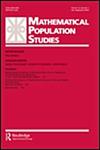Branching random walk in a random time-independent environment
IF 1.3
3区 社会学
Q3 DEMOGRAPHY
引用次数: 1
Abstract
ABSTRACT In a lattice population model, particles move randomly from one site to another as independent random walks, split into two offspring, or die. If duplication and mortality rates are equal and take the same value over all lattice sites, the resulting model is a critical branching random walk (characterized by a mean total number of offspring equal to ). There exists an asymptotical statistical equilibrium, also called steady state. In contrast, when duplication and mortality rates take independent random values drawn from a common nondegenerate distribution (so that the difference between duplication and mortality rates has nonzero variance), then the steady state no longer exists. Simultaneously, at all lattice sites, if the difference between duplication and mortality rates takes strictly positive values with strictly positive probability, the total number of particles grows exponentially. The lattice includes large connected sets where the duplication rate exceeds the mortality rate by a positive constant amount, and these connected sets provide the growth of the total population. This is the supercritical regime of branching processes. On the other hand, if the difference between duplication and mortality rates is almost surely negative or null except when it is almost surely zero, then the total number of particles vanishes asymptotically. The steady state can be reached only if the difference between duplication and mortality rates is almost surely zero.随机时间无关环境下的分支随机漫步
在晶格种群模型中,粒子以独立随机游动的方式从一个位置随机移动到另一个位置,分裂成两个子代,或者死亡。如果复制率和死亡率相等,并且在所有格点上取相同的值,则得到的模型是一个临界分支随机漫步(其特征是后代的平均总数等于)。存在一个渐近统计平衡,也称为稳态。相反,当复制率和死亡率从一个共同的非退化分布中取独立的随机值时(因此复制率和死亡率之间的差异具有非零方差),则稳态不再存在。同时,在所有点阵位置,如果复制率和死亡率之差取严格正值,且概率为严格正,则粒子总数呈指数增长。晶格包括复制率超过死亡率一个正常数的大连接集,这些连接集提供了总体的增长。这就是分支过程的超临界状态。另一方面,如果复制率和死亡率之间的差异几乎肯定为负或为零,除非它几乎肯定为零,那么粒子总数就会逐渐消失。只有当复制率和死亡率之间的差异几乎肯定为零时,才能达到稳定状态。
本文章由计算机程序翻译,如有差异,请以英文原文为准。
求助全文
约1分钟内获得全文
求助全文
来源期刊

Mathematical Population Studies
数学-数学跨学科应用
CiteScore
3.20
自引率
11.10%
发文量
7
审稿时长
>12 weeks
期刊介绍:
Mathematical Population Studies publishes carefully selected research papers in the mathematical and statistical study of populations. The journal is strongly interdisciplinary and invites contributions by mathematicians, demographers, (bio)statisticians, sociologists, economists, biologists, epidemiologists, actuaries, geographers, and others who are interested in the mathematical formulation of population-related questions.
The scope covers both theoretical and empirical work. Manuscripts should be sent to Manuscript central for review. The editor-in-chief has final say on the suitability for publication.
 求助内容:
求助内容: 应助结果提醒方式:
应助结果提醒方式:


